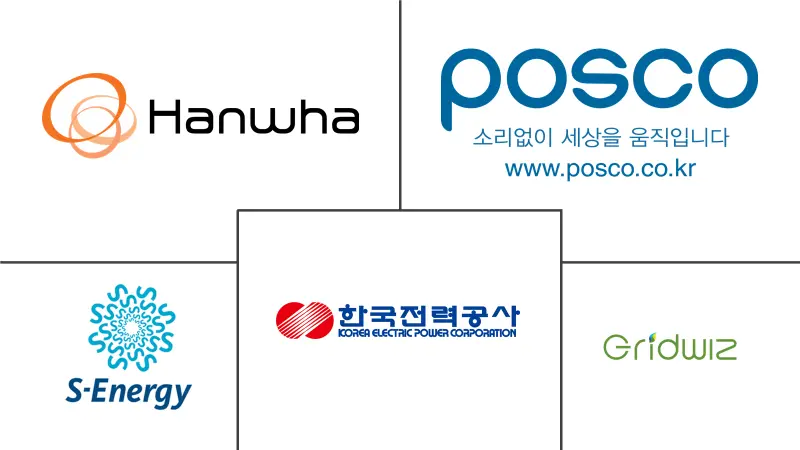Market Size of South Korea Renewable Energy Industry

| Study Period | 2019 - 2029 |
| Base Year For Estimation | 2023 |
| Forecast Data Period | 2024 - 2029 |
| Historical Data Period | 2019 - 2022 |
| CAGR | > 5.50 % |
| Market Concentration | Medium |
Major Players
*Disclaimer: Major Players sorted in no particular order |
South Korea Renewable Energy Market Analysis
The South Korean renewable energy market is expected to register a CAGR of more than 5.5% during the forecast period.
- Over the medium term, factors such as reducing fossil fuel import dependence, rising environmental awareness, and the government's push to align with the Paris Climate Accords are expected to boost the demand for the South Korean renewable energy market during the forecast period.
- On the other hand, significant dependency on nuclear power is likely to restrain market growth.
- Nevertheless, the South Korean government is targeting an increase in the share of its renewable energy mix to 20% by 2030 and up to 42% by 2034. This is expected to present significant opportunities for the players involved in the market.
South Korea Renewable Energy Industry Segmentation
Renewable energy refers to energy sources that are replenished naturally and are therefore considered sustainable and environmentally friendly. Examples of renewable energy sources include solar, wind, hydropower, geothermal, and biomass. These sources of energy are considered renewable because they are replenished naturally and continuously, unlike non-renewable sources of energy such as fossil fuels (coal, oil, and gas), which are finite resources that will eventually be depleted.
South Korean renewable energy is segmented by type. By type, the market is segmented into hydro, wind, solar, and other types. For each segment, market sizing and forecasts have been done based on megawatts (MW).
| Type | |
| Wind | |
| Solar | |
| Hydro | |
| Other Types |
South Korea Renewable Energy Market Size Summary
The South Korean renewable energy market is poised for significant growth, driven by government initiatives and a shift towards sustainable energy sources. The country's commitment to reducing fossil fuel dependency and aligning with international climate agreements has spurred investments in renewable energy. Despite challenges such as reliance on nuclear power, the government aims to increase the renewable energy share in its energy mix substantially by 2030 and beyond. This strategic focus is expected to create substantial opportunities for market participants, particularly in solar and wind energy sectors. The rapid adoption of solar energy, facilitated by innovative solutions like utility-scale solar farms on reclaimed land, underscores the country's proactive approach to expanding its renewable energy capacity.
South Korea's renewable energy landscape is characterized by a blend of government support, strategic partnerships, and technological advancements. The country's ambitious targets for CO2 emission reductions and renewable energy expansion have led to significant investments in projects like offshore wind farms and solar energy facilities. Collaborations between local and international companies, such as the partnership between GE Renewable Energy and Hyundai Electric, highlight efforts to localize and enhance renewable energy infrastructure. The market's growth is further supported by a robust solar manufacturing sector and relaxed permitting regulations, which are expected to drive down costs and accelerate the deployment of renewable energy projects. As a result, South Korea is well-positioned to enhance its renewable energy capacity and reduce its carbon footprint in the coming years.
South Korea Renewable Energy Market Size - Table of Contents
-
1. MARKET OVERVIEW
-
1.1 Introduction
-
1.2 Renewable Energy Installed Capacity and Forecast, in MW, till 2028
-
1.3 Recent Trends and Developments
-
1.4 Government Policies and Regulations
-
1.5 Market Dynamics
-
1.5.1 Drivers
-
1.5.2 Restraints
-
-
1.6 Supply Chain Analysis
-
1.7 PESTLE ANALYSIS
-
-
2. MARKET SEGMENTATION
-
2.1 Type
-
2.1.1 Wind
-
2.1.2 Solar
-
2.1.3 Hydro
-
2.1.4 Other Types
-
-
South Korea Renewable Energy Market Size FAQs
What is the current South Korea Renewable Energy Market size?
The South Korea Renewable Energy Market is projected to register a CAGR of greater than 5.5% during the forecast period (2024-2029)
Who are the key players in South Korea Renewable Energy Market?
Hanwha Corp, Korea Electric Power Corporation, POSCO Energy Co Ltd, S-Energy Co., Ltd and Gridwiz Inc. are the major companies operating in the South Korea Renewable Energy Market.

